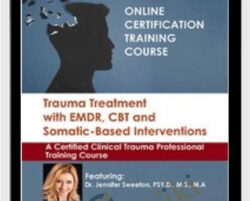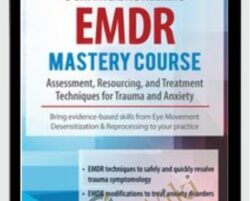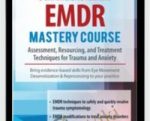EMDR has helped thousands of clients reclaim their lives; quickly and consistently helping them find relief from the trauma and anxiety that plague them.But without guidance, and hands-on practice, you’re unable to bring this groundbreaking evidence-based treatment to your clients who so desperately need it.This EMDR Mastery Course recording is your chance to get powerful and proven skills and techniques from EMDR so you can move your clients from surviving to thriving!You’ll be given a roadmap to help clients manage disturbing feelings, safely process their traumatic memories, reduce fears and anxiety, and help them to develop the resources they need to achieve and maintain recovery.This intensive training also includes hands-on opportunities for you to practice, reinforcing what you’ve learned and allowing you to gain confidence in using your new skills.Take your treatment to the next level with EMDR skills and techniques to quickly and safely bring relief from trauma and anxiety to your clients!Determine the role of the autonomic nervous system in trauma and anxiety symptomology.Articulate the clinical implications of the freeze response in trauma treatment.Characterize the potential neurobiological mechanisms of change in the empirically validated EMDR approach.Specify how EMDR techniques can build dual awareness in clients to treat the avoidance that makes trauma and anxiety treatment challenging.Employ the 8 Phases of the EMDR protocol.Determine which clients you should use EMDR with.Appraise the relevance of Polyvagal Theory and early trauma in EMDR work.Communicate the central principle of the Adaptive Information Processing Theory and establish how it informs the EMDR approach.Analyze resourcing strategies from EMDR that clinicians can use to help facilitate the processing of trauma.Specify the steps clinicians must take to emphasize safety during EMDR sessions.Determine how EMDR can be modified to treat anxiety disorders.Differentiate between EMDR strategies recommended for trauma and EMDR strategies recommended for anxiety.Characterize how EMDR techniques can be used to reinforce and activate positive neural networks.Defend how EMDR can be modified to work with complex/developmental trauma to directly treat traumatic memories.Evaluate strategies that can help foster the critical connection between client and therapist in EMDR therapy.Formulate the order of operations for attachment-based EMDR treatment to resolve relational trauma.Articulate how EMDR can be modified to work with Borderline Personality Disorder, Dissociative Identity Disorder, and Generalized Anxiety Disorder.Differentiate between EMDR and Brainspotting by communicating the strengths and limitations of each.Get EMDR Mastery Course: Assessment, Resourcing and Treatment Techniques for Trauma and Anxiety – Jennifer Sweeton, Only Price $239The Neuroscience of Trauma and AnxietyIntroduction to the autonomic system (ANS)Fight, flight, freeze, fawn survival responsesPolyvagal Theory, and types of freeze responsesKey brain areas involved in trauma and anxietyClinical implications of the freeze responseMechanisms of Change: How EMDR and Other Treatment Approaches WorkThe neuroscience of exposure therapy and cognitive therapyThe neuroscience of relaxation exercisesEMDR and other “transformative therapies”Mechanisms of changeWhy EMDR works so well from a brain perspectiveAssessment: Connect Symptoms and Presentations to a DiagnosisNervous system switched on/off – PTSD and DepressionUnderactivations and weakened connectionsTrauma memories and intrusive thoughtsPhobias, anxiety and insula hyperactivationEmotional hijackings and implicit memory: Basal ganglia and amygdalaWhy treating avoidance is critical in anxiety and traumaDSM-5® symptoms in a nutshellConnect Your Client to a DiagnosisSimple vs. complex traumaIntergenerational traumaSymptom clusters and physicalmanifestationsCAPS-5 and PCL-5Primary Care PTSD ScreenDual diagnosisEMDR as Applied NeuroplasticityHow EMDR builds dual awareness to treat avoidanceWhat you are thinking about is the network you’re inYou need to activate a network to change itNeurons that fire together, wire together (Hebb’s Rule)EMDR as neuroentrainmentPractical EMDR Techniques and Protocols to Move Clients from Surviving to ThrivingEMDR Assessment, Resourcing, Eye Movements and More: How to Work with the Original 8-Phase ModelClient history and treatment planningHow to resource: Create a safe spaceAssessment: Choose a target, SUDS, connect with the image/emotions/thoughtDesensitization: tactile vs. auditory vs. eye movementHow to use Touchpoints, Theratapper, CDsPositive Cognition Installation: Likert scale 1-7Body Scan: Locating tension and distress in the bodyClosure: Closing the neural network and the 6-hour windowRe-evaluationWhen to Use EMDR in Trauma and Anxiety TreatmentDemonstrations and experiential exercisesSingle event traumaAnxiety disorders involving imaginal exposureDemonstration of original 8-Phase Model***Experiential exercises with groups of three: client, therapist, observerPreparation and assessmentDesensitizationPositive cognition and body scanEMDR for Direct Treatment of Traumatic MemoriesModifications for complex/developmental traumaDo not use standard protocol – Rationale for modificationsResourcing strategies:ContainerComfortable placeNurturing figureProtective figureCircle of supportTechniques to reinforce and activate positive neural networksRelevance of Polyvagal Theory, early trauma, and EMDRSensory motor modifications and somatic approachesHow to build Dual AwarenessAdaptive Information Processing TheoryEMDR techniques to bring traumatic memories into the prefrontal cortexAttachment-Based EMDR for Resolving Relational TraumaStrategies to foster the critical connection between client and therapistHow to emphasize safety during sessionsGuidance on order of operations:Resourcing with multisensory guided imageryActivate trauma networkDesensitization roundAsk, “What is coming up?”How to install positive cognitionIdentify and resolve remaining tension or distress in the bodyDebrief clients to ensure embodimentEMDR Modifications for Anxiety DisordersModifications for phobias and generalized anxietyResourcing strategies for self-efficacy and controlImaginal exposure and exposure through pictures and videosTechniques to reinforce and activate positive neural networksHow to build Dual Awareness and reduce avoidanceEMDR Modifications for Other DisordersBorderline Personality DisorderDissociative Identity DisorderOCDGeneralized Anxiety DisorderEMDR vs Brainspotting vs EFT vs NeuromodulationWhen to use eachStrengths and limitations of eachOverview of how to conduct a Brainspotting sessionOverview of how to conduct an EFT sessionIntegrating neuromodulation and EMDR for faster, more effective treatmentResearch Limitations and Potential RisksGet EMDR Mastery Course: Assessment, Resourcing and Treatment Techniques for Trauma and Anxiety – Jennifer Sweeton, Only Price $239Tag: EMDR Mastery Course: Assessment, Resourcing and Treatment Techniques for Trauma and Anxiety – Jennifer Sweeton Review. EMDR Mastery Course: Assessment, Resourcing and Treatment Techniques for Trauma and Anxiety – Jennifer Sweeton download. EMDR Mastery Course: Assessment, Resourcing and Treatment Techniques for Trauma and Anxiety – Jennifer Sweeton discount.
 Trauma Treatment with EMDR, CBT and Somatic-Based Interventions: A Certified Clinical Trauma Professional Training Course – Jennifer Sweeton
₹32,038.00
Trauma Treatment with EMDR, CBT and Somatic-Based Interventions: A Certified Clinical Trauma Professional Training Course – Jennifer Sweeton
₹32,038.00
 Full Conference Audio
₹7,138.00
Full Conference Audio
₹7,138.00
EMDR Mastery Course: Assessment, Resourcing and Treatment Techniques for Trauma and Anxiety
₹39,010.00





